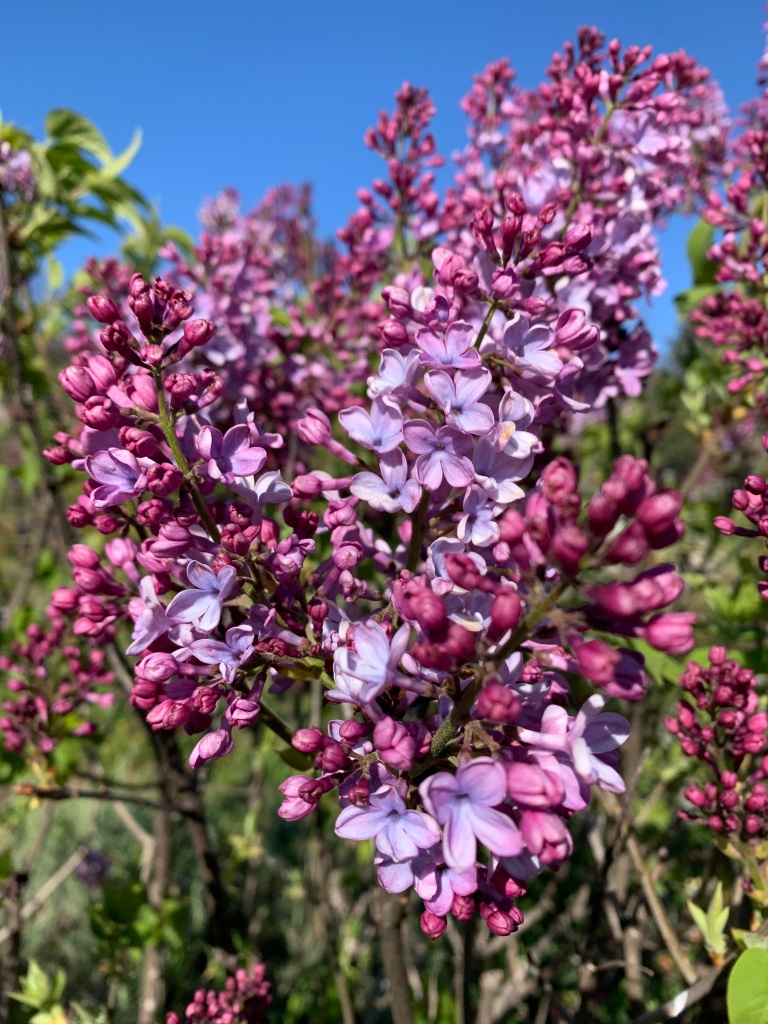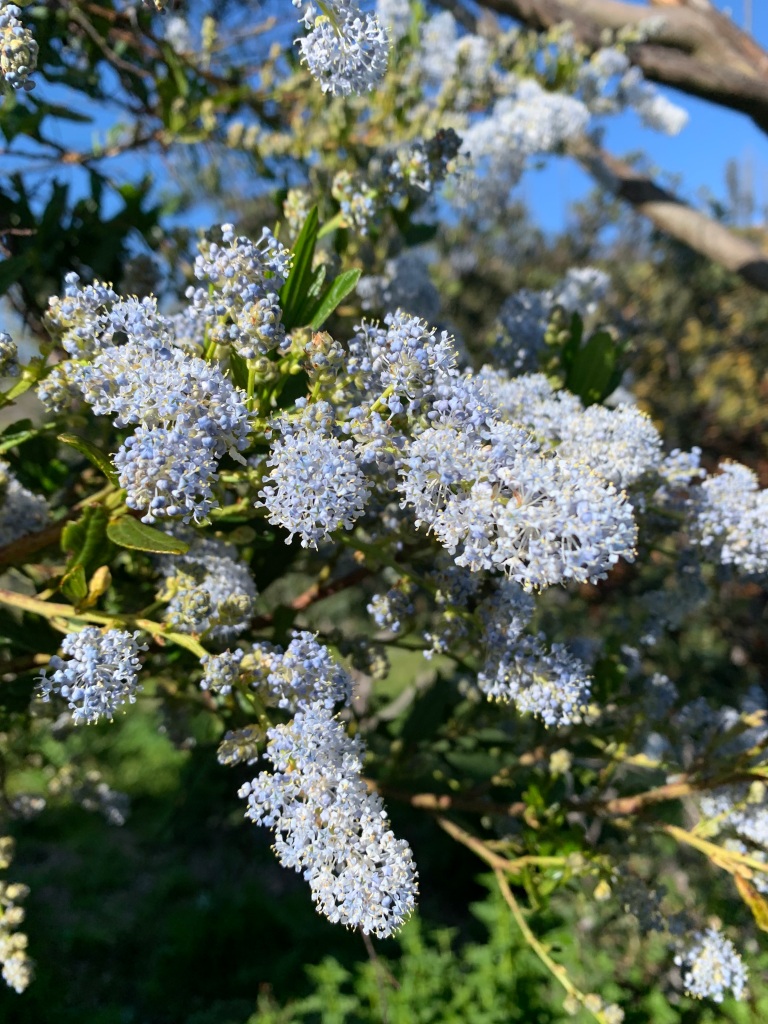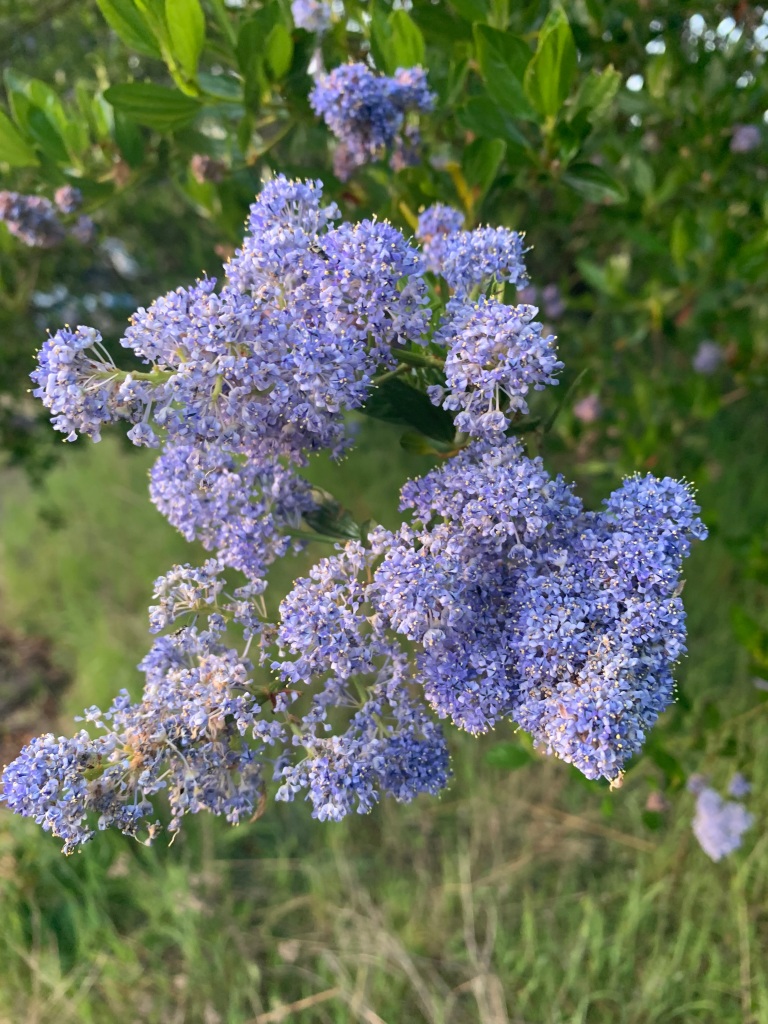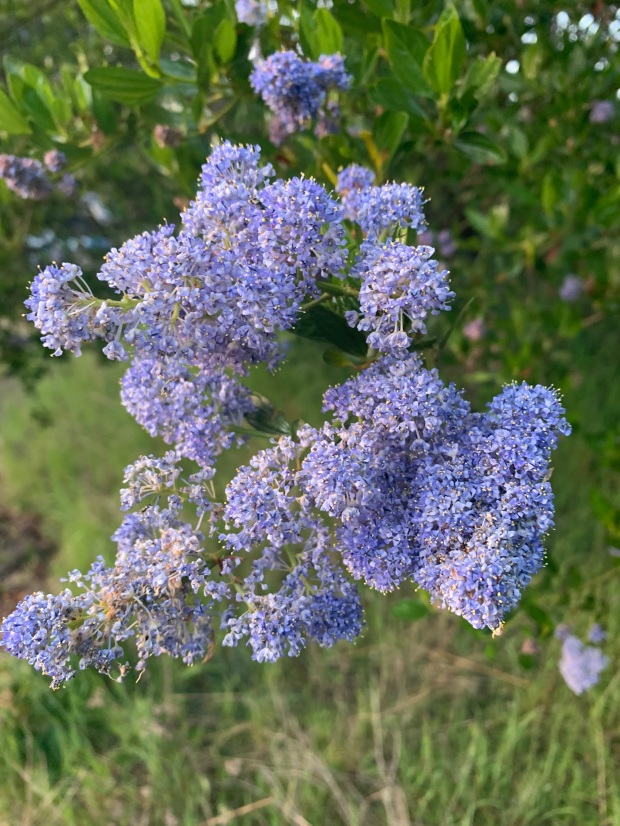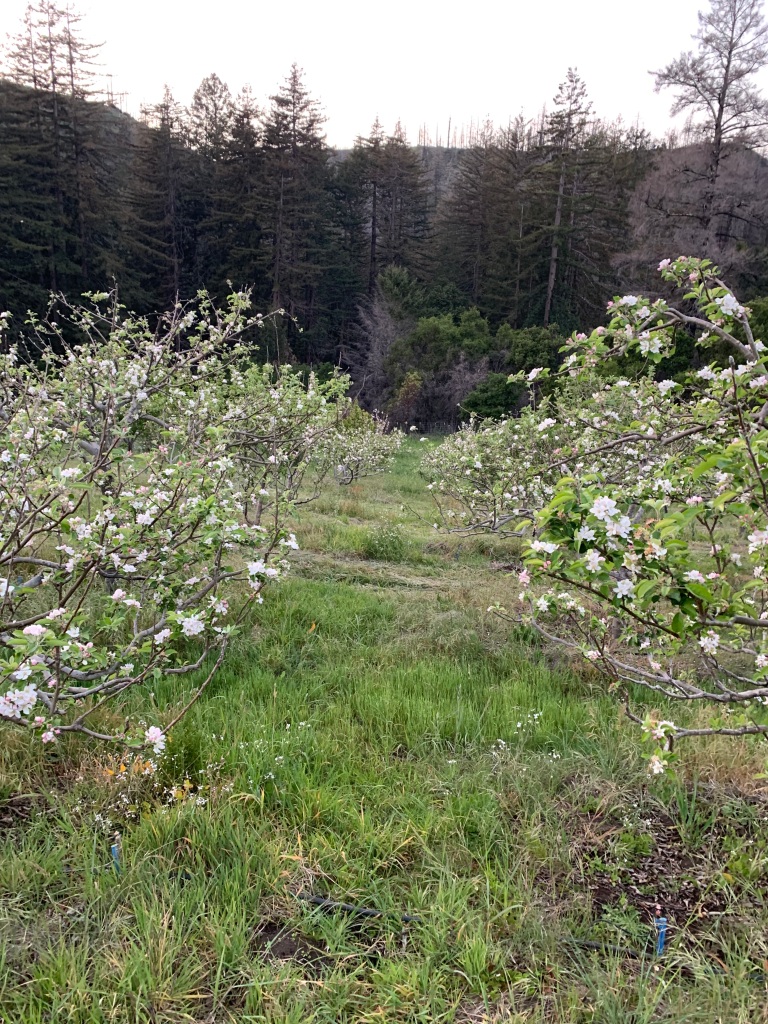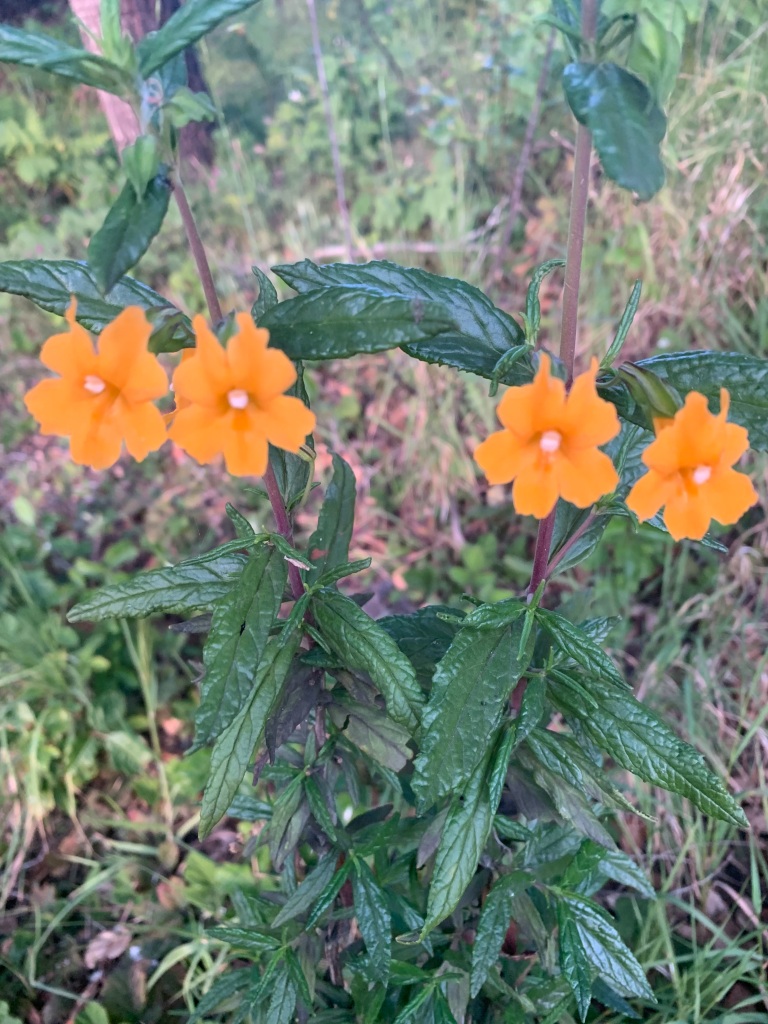You’ll soon be familiar with one of this area’s most important native shrubs and its ecological interactions. The best poets, writers, and film makers have intimate familiarity with plants and ecosystems, enabling them to transmit their hearts and imaginations realistically. To be part of this place, to appreciate the nature around us, you might consider doing the same. Most start with the dominant trees – those are easy…aim for 10 species, and you’ll have a great start! The next step is to name and know the stories of the top 10 dominant shrubs. In this case, you’ll certainly include a shrub with a confusing array of common names: California lilac, blue blossom, wood tick bush, soap blossom, or (in yesteryear) blue myrtle (Ceanothus thyrsiflorus).
Whatever you call it, this shrub is starting to blossom right now with long fat clusters of tiny pale blue flowers, shaking with pollinators, and filling the air with incredible perfume.
Wild Lilac?
California lilac isn’t even closely related to the ‘normal’ lilac, but it is easily as commonly found in gardens. The European lilac is related to olives, has medium-sized leaves, and 4-petaled flowers with heady, sweet perfume. Our native wild lilac has a dusty-sweet scent, but you’ll have to squint or use a magnifying glass to see that the tiny flowers have 5 petals.
Garden Plants
There are many relatives of blue blossom, and you can even find some side-by-side in our area. My favorite is warty leaved Ceanothus, Ceanothus papillosus, which likes to grow in chaparral. This warty-leaved type has sapphire-blue flowers and a very memorable, sweet-resinous smell emanating from its leaves, especially when it is hot out. This diversity of Ceanothus types and their stunning beauty have made them very popular as garden plants. If you have well-drained soil and some space in your garden, you might consider adding one not only for their flower beauty, but for their evergreen beautiful leaves, as well as their attractiveness to wildlife. You can find forms from tight ground covers to tall and treelike with flowers from white to deep, dark blue. The flower scents are that variable, too- from very sweet to very musky.
Twenty Years Ago
Twenty years ago, it was a much more unusual treat to encounter California lilac in the natural landscape around Santa Cruz. The same can still be said of the areas that haven’t burned in anyone’s memory. Big, burly blue blossom could hardly be called a shrub back then; they seemed more like small trees, with 1’ thick, gnarly trunks and barely organized canopies festooned thickly with pale blue flowers. Those powder blue puffs stood out singly or in small groves, poking up through old manzanitas or coyotebrush, visible a half mile away for their brief flowering period and then disappearing for the remainder of the year, blending in perfectly.
And Then There Was Fire
California lilac is a pyrophile. How can life love fire, such a destructive force, cooking and searing plants and animals alike as the wind-fanned flames race across hill and valley, crackling and hissing, turning everything to smoking char? For blue blossom, there is naturally no next generation without fire and adults are lucky to live 50 years. These shrubs make a lot of seeds, which sit in the soil waiting for the winter after fire to germinate. Sleeping seeds awaken when they feel the sun and the sun-warmed soil, then seeds that have accumulated in the soil for years germinate. Carpets of blue blossom seedlings spring up, and 3 years after the fire are 6’ tall and blooming, soon raining seeds in preparation for the next fire birthing.
Getting Around
Blue blossom seeds don’t appear adapted to dispersing far from their parent shrubs. The seeds don’t have maple seed wings or dandelion fluff to disperse on the wind. And, the seeds don’t have obviously attractive fruit like acorns or avocados. But, when the seed pods explode on hot days, cracking and popping seeds loose from the mother plants, wildlife become alert to the new availability of food. Quail have been known to gobble them up, as they scratch and peck in the shrubland understory. But quail and other birds don’t digest the seeds completely: the result, perfectly viable seeds being spread across the landscape, far from mother plants.
Not Just Fire
California lilac doesn’t require fire. Any disturbance that churns up the soil and shines new sunlight onto the seeds will work just fine. So, you can find new shrubs germinating in the wake of road or trail building, logging, and even suburban gardening. There are many other sneaky species like this: ones that appear abundant after fire, almost as if they require fire to germinate. There are many fewer species that do actually require fire to germinate- many of those are triggered to sprout by chemicals leached out of charcoal in the winter rains following wildfire.
California Lilac Uses
What good is this shrub? The vigor of this species in germinating after wildfire may be important for a few reasons. First, the shrubs might help to cover and then hold soil in place after fire. Second, the species has special roots that allow it to capture atmospheric Nitrogen and make it available as a plant nutrient. Adding this fertilizer to the ecosystem may help adjacent plants to grow and recover after wildfire. Blue blossom tends to grow especially well on poor soils, so it may be assisting many other species to make it in this soil-inhospitable situation.
Moths, Butterflies and Other Insects
Besides being good bird seed, moths and butterflies depend on California lilac. Ceanothus silk moth feeds on this species (its cocoons were used ceremonially by tribal peoples); many other species of butterfly and moths likewise raise their young on blue blossom. Tortoiseshell butterflies migrate from the Sierra Nevada to raise their young on blue blossom here along the coast. Somehow, the young know how to get back to those mountains to raise their children, which in turn fly higher in the Sierra and that high-mountain-raised generation is the one that comes to the coast.
Besides the post-fire explosion of tortoiseshell butterflies, one of my favorite phenomena are the annual gatherings of what I call blue blossom dancers. Thousands of tiny beetles fly in clouds above the blossoming shrubs at sunset, their silver-shining silhouettes are fascinating to watch pulsing and undulating in their fantastic annual ritual dance. Throughout the day, you can see those dancers feasting on pollen in the flower clusters, preparing for their energetic sunset display.
Where to See Blue Blossom….and a Cleaning Trick
Head for the post-fire ecological footprint! I hear that some Big Basin trails are open as are the trails in the Fall Creek Unit of Henry Cowell State Park. Both areas have huge rafts of California lilac just starting to flower. It is worth going before the winds on a warm day to immerse yourself in the scent. Do yourself a favor and get close to the flower clusters to see the awesome diversity of pollinators. If there is water nearby, grab a big hank of flowers and get to the water. Holding the mass of flowers between your wet hands, rub them together and you can experience the sudsy nature of soap blossom. Like apricot scrub, it has just the right amount of abrasiveness to help the nicely scented suds help clean your hands.
See, you know this! Ceanothus. You are on your way.
-this post originally made available via Bruce Bratton at his BrattonOnline.com blog; check it out…weekly updates…the BEST local news source in the Monterey Bay area.

